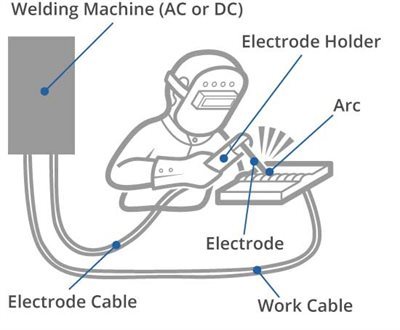

Arc welding is a fusion welding process used to join metals. An electric arc from an AC or DC power supply creates an intense heat of around 6500°F which melts the metal at the join between two work pieces.

The arc can be either manually or mechanically guided along the line of the join, while the electrode either simply carries the current or conducts the current and melts into the weld pool at the same time to supply filler metal to the join.
Because the metals react chemically to oxygen and nitrogen in the air when heated to high temperatures by the arc, a protective shielding gas or slag is used to minimise the contact of the molten metal with the air. Once cooled, the molten metals solidify to form a metallurgical bond.
This process can be categorised into two different types; consumable and non-consumable electrode methods.
Also known as Gas Metal Arc Welding (GMAW), uses a shielding gas to protect the base metals from contamination.
Also known as manual metal arc welding (MMA or MMAW), flux shielded arc welding or stick welding is a process where the arc is struck between the metal rod (electrode flux coated) and the work piece, both the rod and work piece surface melt to form a weld pool. Simultaneous melting of the flux coating on the rod will form gas, and slag, which protects the weld pool from the surrounding atmosphere. This is a versatile process ideal for joining ferrous and non-ferrous materials with a range of material thicknesses in all positions.
Created as an alternative to SMAW, FCAW uses a continuously fed consumable flux cored electrode and a constant voltage power supply, which provides a constant arc length. This process either uses a shielding gas or just the gas created by the flux to provide protection from contamination.
A frequently-used process with a continuously-fed consumable electrode and a blanket of fusible flux which becomes conductive when molten, providing a current path between the part and the electrode. The flux also helps prevent spatter and sparks while suppressing fumes and ultraviolet radiation.
A vertical process used to weld thick plates (above 25mm) in a single pass. ESW relies on an electric arc to start before a flux addition extinguishes the arc. The flux melts as the wire consumable is fed into the molten pool, which creates a molten slag on top of the pool. Heat for melting the wire and plate edges is generated through the molten slag’s resistance to the passage of the electric current. Two water-cooled copper shoes follow the process progression and prevent any molten slag from running off.
Similar to flash welding, SW joins a nut or fastener, usually with a flange with nubs that melt to create the join, to another metal piece.
Also known as Gas Tungsten Arc Welding (GTAW), uses a non-consumable tungsten electrode to create the arc and an inert shielding gas to protect the weld and molten pool against atmospheric contamination.
Similar to TIG, PAW uses an electric arc between a non-consumable electrode and an anode, which are placed within the body of the torch. The electric arc is used to ionise the gas in the torch and create the plasma, which is then pushed through a fine bore hole in the anode to reach the base plate. In this way, the plasma is separated from the shielding gas.

Tunaak Metals Nigeria Limited is a structural steel prefabrication company, which specializes in fabrication of all type of structures, ranging from storage tanks, industrial and marine pipping and miscellaneous steel structures in the civil, industrial and marine sectors. With innovative ideas in steel fabrication we build world class products for a better community. We provide essential and specialize training for our staff to enable us go beyond the expectations of our clients, while implementing adequate safety measures which protects the environment and persons.